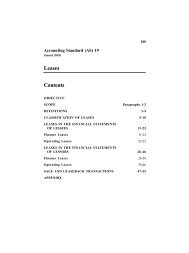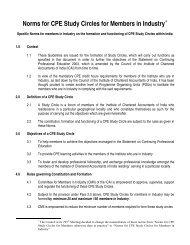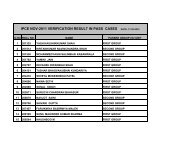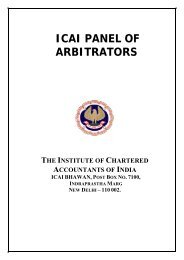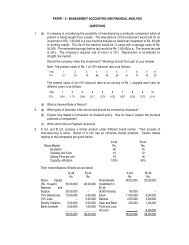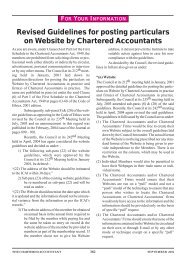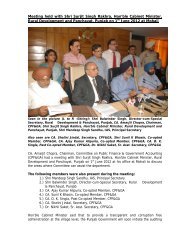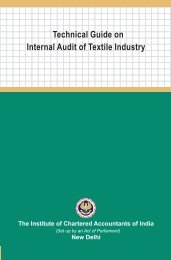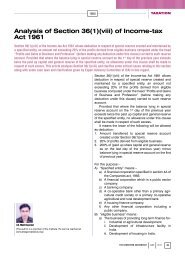The Chartered Accountant
The Chartered Accountant
The Chartered Accountant
Create successful ePaper yourself
Turn your PDF publications into a flip-book with our unique Google optimized e-Paper software.
(a) Threats to independence,<br />
which may be categorised as:<br />
self-interest threats, self-review<br />
threats, advocacy threats, familiarity<br />
threats, and intimidation<br />
threats; and<br />
(b) Safeguards created by the profession,<br />
legislation or regulation,<br />
safeguards within the entity,<br />
and safeguards within the firm’s<br />
own systems and procedures.<br />
<strong>The</strong> communication required by<br />
paragraph 13(a) may include an inadvertent<br />
violation of relevant ethical<br />
requirements as they relate to auditor<br />
independence, and any remedial action<br />
taken or proposed.<br />
A27. <strong>The</strong> communication requirements<br />
relating to auditor independence<br />
that apply in the case of listed<br />
entities may also be relevant in the case<br />
of some other entities, particularly<br />
those that may be of significant public<br />
interest because, as a result of their<br />
business, their size or their corporate<br />
status, they have a wide range of stakeholders.<br />
Examples of entities that are<br />
not listed entities, but where communication<br />
of auditor independence may<br />
be appropriate, include public sector<br />
entities, credit institutions, insurance<br />
companies, and retirement benefit<br />
funds. On the other hand, there may<br />
be situations where communications<br />
regarding independence may not<br />
be relevant, for example, where all<br />
of those charged with governance<br />
have been informed of relevant facts<br />
through their management activities.<br />
This is particularly likely where the entity<br />
is owner-managed, and the auditor’s<br />
firm and network firms have little<br />
involvement with the entity beyond a<br />
financial statement audit.<br />
Supplementary Matters (Ref: Para. 3)<br />
A28. Those charged with governance<br />
are responsible for ensuring, through<br />
oversight of management, that the<br />
entity establishes and maintains internal<br />
control to provide reasonable<br />
assurance with regard to reliability of<br />
financial reporting, effectiveness and<br />
efficiency of operations and compliance<br />
with applicable laws and regula-<br />
STANDARDS<br />
tions.<br />
A29. <strong>The</strong> auditor may become aware<br />
of supplementary matters that do not<br />
necessarily relate to the oversight of<br />
the financial reporting process but<br />
which are, nevertheless, likely to be<br />
significant to the responsibilities of<br />
those charged with governance in<br />
overseeing the strategic direction of<br />
the entity or the entity’s obligations<br />
related to accountability. Such matters<br />
may include, for example, significant<br />
deficiencies in governance structures<br />
or processes, and significant decisions<br />
or actions by senior management that<br />
lack appropriate authorisation.<br />
A30. In determining whether to communicate<br />
supplementary matters with<br />
those charged with governance, the<br />
auditor may discuss matters of this<br />
kind, of which the auditor has become<br />
aware, with the appropriate level of<br />
management, unless it is inappropriate<br />
to do so in the circumstances.<br />
A31. If a supplementary matter is<br />
communicated, it may be appropriate<br />
for the auditor to make those charged<br />
with governance aware that:<br />
(a) Identification and communication<br />
of such matters is incidental<br />
to the purpose of the audit,<br />
which is to form an opinion on<br />
the financial statements;<br />
(b) No procedures were carried out<br />
with respect to the matter other<br />
than any that were necessary to<br />
form an opinion on the financial<br />
statements; and<br />
(c) No procedures were carried<br />
out to determine whether other<br />
such matters exist.<br />
<strong>The</strong> Communication Process<br />
Establishing the Communication<br />
Process (Ref: Para. 14)<br />
A32. Clear communication of the<br />
auditor’s responsibilities, the planned<br />
scope and timing of the audit, and the<br />
expected general content of communications<br />
helps establish the basis for<br />
effective two-way communication.<br />
A33. Matters that may also contribute<br />
to effective two-way communica-<br />
tion include discussion of:<br />
l <strong>The</strong> purpose of communications.<br />
When the purpose is<br />
clear, the auditor and those<br />
charged with governance are<br />
better placed to have a mutual<br />
understanding of relevant issues<br />
and the expected actions<br />
arising from the communication<br />
process.<br />
l <strong>The</strong> form in which communications<br />
will be made.<br />
l <strong>The</strong> person(s) in the audit team<br />
and amongst those charged<br />
with governance who will communicate<br />
regarding particular<br />
matters.<br />
l <strong>The</strong> auditor’s expectation that<br />
communication will be two-way,<br />
and that those charged with<br />
governance will communicate<br />
with the auditor, matters they<br />
consider relevant to the audit,<br />
for example, strategic decisions<br />
that may significantly affect the<br />
nature, timing and extent of<br />
audit procedures, the suspicion<br />
or the detection of fraud, and<br />
concerns with the integrity or<br />
competence of senior management.<br />
l <strong>The</strong> process for taking action<br />
and reporting back on matters<br />
communicated by the auditor.<br />
l <strong>The</strong> process for taking action<br />
and reporting back on matters<br />
communicated by those charged<br />
with governance.<br />
A34. <strong>The</strong> communication process<br />
will vary with the circumstances, including<br />
the size and governance structure<br />
of the entity, how those charged<br />
with governance operate, and the<br />
auditor’s view of the significance of<br />
matters to be communicated. Difficulty<br />
in establishing effective two-way<br />
communication may indicate that the<br />
communication between the auditor<br />
and those charged with governance is<br />
not adequate for the purpose of the<br />
audit (see paragraph A48).<br />
Considerations Specific to Smaller<br />
THE CHARTERED ACCOUNTANT 1097 DECEMBER 2008



